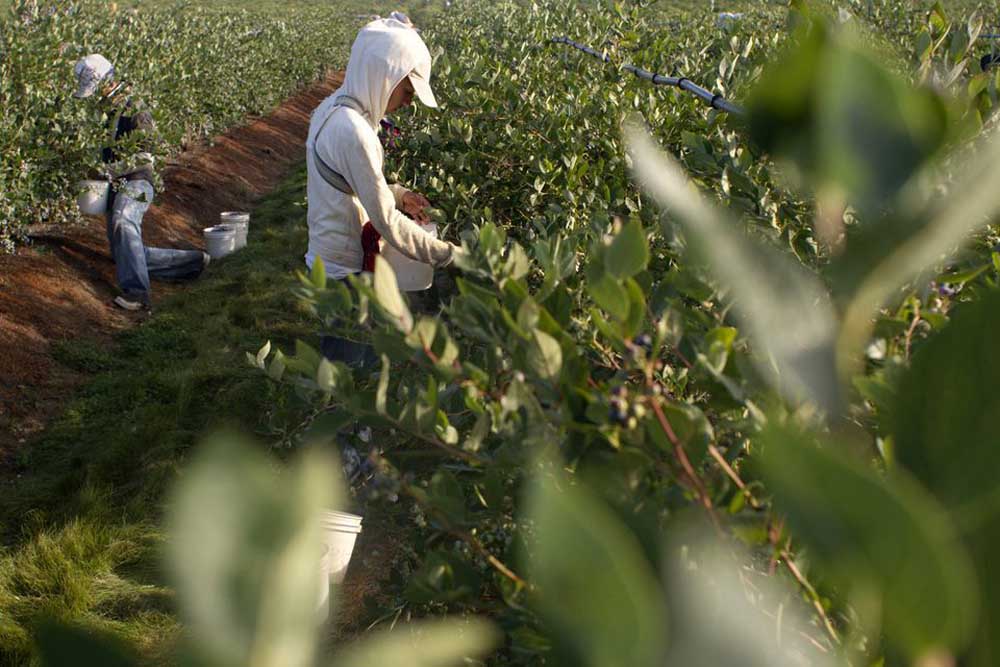Oregon farmers, worker advocates reach impasse over improvements to labor camps. Will the governor help?
Published 6:25 am Wednesday, May 15, 2024

- Workers harvesting blueberries in Woodburn on July 15, 2012.
After more than five years, negotiations between Oregon growers and advocates have reached a deadlock over farmworker housing improvements — despite help from a state-funded facilitator — and advocates are now asking Gov. Tina Kotek for help.
Both sides began meeting in November 2018 to hash out changes to the state’s outdated agricultural labor housing standards. The state set no deadline for the adoption of the new rules — one of the concerns raised by advocates who say they are “deeply disappointed by the lack of priority given to this critical racial justice issue.”
Trending
Advocates, including the Oregon Law Center, PCUN, which is Oregon’s largest farmworkers union, and NOWIA Unete Center for Farm Worker Advocacy, are calling for significant improvements to worker housing that they say would ensure the safety and health of farmworkers and their families. Those improvements include updates to electrical, septic and well systems, as well as plumbing and structural soundness. They would also like to see changes to the distance between some of the housing and the fields because they are worried with pesticide drift, especially for sites that have makeshift kitchens outside, adjacent to the units.
Growers have pushed, saying the updates are “extreme” and would be too costly and could cause farms to go bankrupt, leaving farmworkers homeless.
Multiple growers declined to comment for this story or didn’t return calls seeking comment.
This year, there are 455 agricultural labor housing sites registered across the state, according to Oregon’ Occupational Safety and Health division’s registry. The number of occupancies vary for each, but advocates estimate those sites house about 15,000 farmworkers and their families year-round and seasonally.
Anca Matica, a spokesperson for the governor, said Kotek takes concerns raised by advocates and growers “seriously.”
“The Governor believes that there is room for improvement on the issue of agriculture labor housing,” she said in an email.
Trending
Matica said Kotek’s office will remain in close communication with Department of Consumer and Business Services, which houses Oregon OSHA, to ensure the concerns are addressed.
Lawmakers in 2023 approved $5 million to assist growers with agriculture labor housing improvements. Oregon also has the Agriculture Workforce Housing Tax Credit program that is designed to give a state income tax credit to those who invest in agriculture labor housing.
Dagoberto Morales, director at NOWIA Unete Center for Farm Worker Advocacy, which is involved with the negotiations, said he doesn’t believe money is the issue.
“It’s due to a lack of interest,” he said in Spanish.
Talks drag on
Negotiations have not only dragged on – in part due to the pandemic – but they also became contentious.
OSHA, which enforces the rules on employer-provided housing, hired a dispute resolution company for a little more than $8,000 to help facilitate talks between both groups beginning in January.
Disagreements continued, however, with some growers suspending their participation from meetings in March. The last scheduled meeting was in April and neither side is content with the results.
In a late April letter, obtained by The Oregonian, a coalition of advocates tell Kotek the proposed rule changes “fall short in addressing necessary and long overdue infrastructure improvements.”
The current regulations are “alarmingly outdated,” advocates say, and as a result, farmworkers live in crammed spaces that lack flushing toilets, proper sinks, and hygienic food preparation areas.
More than 50 organizations, such as the Northwest Workers’ Justice Project, signed on to the letter with their logos, along with the Oregon Law Center and PCUN.
In response to the advocates’ letter, Mike Doke, executive director for the Columbia Gorge Fruit Growers, which represent 440 tree fruit growers in Wasco and Hood River counties, said growers value and care about their workers, but advocates are asking for “nice improvements” that don’t fall under the core of health and safety.
Wasco and Hood River counties are home to two-thirds of Oregon’s agricultural workforce housing, he said.
Housing owned by growers represented by the Columbia Gorge Fruit Growers is registered with Oregon OSHA, he added.
“They are in compliance with 2008 standards that are in place now,” Doke said.
He acknowledged some housing sites do have outdoor kitchens and use porta potties or outhouses.
Many labor camps haven’t seen substantial structural changes since the 1970s, Morales said.
“If it’s people of color who are being impacted, there’s little interest” for change, he said in Spanish. “That I can remember, we’ve been fighting for improved housing since the ’90s.”
Aaron Corvin, a spokesperson for Oregon OSHA, said concerns outlined in the letter vary in complexity, but were all shared and discussed during the rulemaking process.
“All are under consideration but no decisions have been made,” he said in written responses.
The groups, part of the Agriculture Labor Housing Rule Advisory Committee, had 24 meetings, with the last four facilitated by Six Rivers Dispute Resolution Center to “maximize” time, Corvin said.
Bringing the groups together, he said, reflects Oregon OSHA’s recognition “that there is room for improvement.”
When asked twice about what happens next, Corvin wasn’t able to provide an answer and only reiterated that no deadline was set for this work.
“Oregon OSHA did not establish a deadline for the rule as the commitment was to take a comprehensive review of the existing rules,” he said, adding that a timeline would not have allowed for a “thoughtful assessment.”
He added that state officials “recognize the importance of moving this rulemaking forward and providing protections for occupants.”
Not having a timeline for the farmworker housing improvements has been part of the challenge, said Martha Sonato, legislative and policy advocate at the Oregon Law Center.
“What’s our end goal here?” she asked. “What’s the deadline? What are the dates?”
‘Times are challenging’
Adam McCarthy, with McCarthy Family Farm, who was among those who declined to comment, referred questions to Doke, with the Columbia Gorge Fruit Growers.
Doke said this process has taken years.
“We’ve had many starts and stops, largely due to the inability of all participating to engage respectfully with each other,” he said.
There was a walkout during at least one of the convenings.
During a November 2023 meeting, growers said they believed the housing rule changes were “moving away from health and safety of workers and focusing on comfort and lifestyle,” and changes would also “reduce farmland,” according to meeting minutes.
Minutes also show some advocates “expressed concern about the direction (of) the meeting” and walked out early.
Advocates told Kotek the quality of farmworker housing should be one that would make anyone feel “comfortable living there.”
Three entities representing growers, including the Columbia Gorge Fruit Growers, in late March sent a letter to OSHA airing their concerns, and informing the agency they were suspending their participation from meetings.
Some of the proposed changes, they said, are broad in scope and fall outside the boundaries of “health and safety,” according to the letter shared with The Oregonian.
“Our members have shared the economic reality that the proposed regulations will likely lead to the loss of multigenerational family farms due to the financial burden the average family farm will be unable to overcome,” the letter reads. “Our members are also increasingly concerned that the draft proposed ALH rules will render agricultural workers homeless.”
For example, a rule change that growers “strongly oppose” would provide portable handwashing stations with hot and cold water, records show.
“Requiring handwashing facilities for portable toilets that provide hot water is unrealistic and extremely difficult to achieve,” growers wrote as part of their feedback on the draft rules. “Portable handwashing stations that provide hot water are incredibly expensive, not readily available, and not at all necessary for hygiene.”
Growers also strongly oppose a rule change that would require sleeping rooms provide at least 100-square-feet of floor space per occupant. They say that would reduce their housing capacity by at least half, forcing them to displace employees, records show.
Doke said growers simply cannot afford some of the proposed improvements.
“Times are very challenging,” he said in writing, “and we participated in the … process to recommend reasonable solutions and improvements to housing but not to force farm families into bankruptcy.”
Sonato with the Oregon Law Center said she wants state leaders to help farmworkers and their families.
“We really just hope that the state will prioritize farmworkers and their safety and health in agriculture labor housing,” she said. “We hope the financial aid that is out there will help alleviate some of the concerns from the industry.”
Yesenia Amaro is an investigative reporter with a focus on social issues and communities of color. Reach her at 503-221-4395; yamaro@oregonian.com








